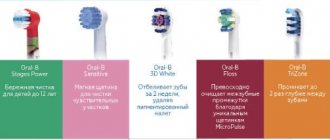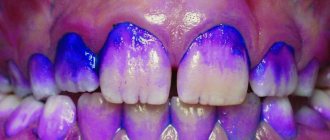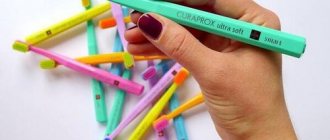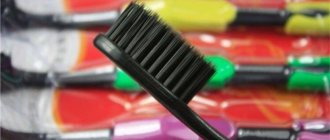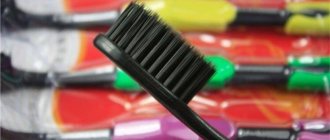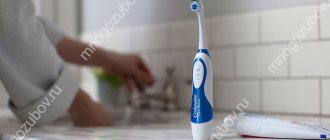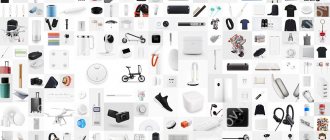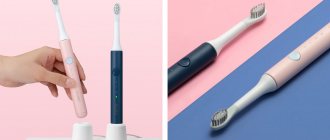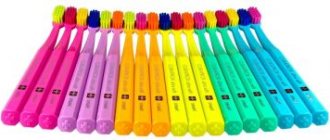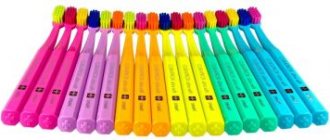In this article
- How to properly store a toothbrush
- Store the brush vertically
- Place the toothbrush with the bristles facing up
- Keep your toothbrush separate from other people's
- Do not enclose the brush in a tight case
- Keep the brush away from “dangerous” places
- Disinfect your toothbrush
- Change your brush regularly
A toothbrush, if stored incorrectly, becomes hazardous to health. Microbes multiply on its bristles, which can lead to the development of infection. In addition, it becomes unusable faster. We list the rules for storing toothbrushes, following which will extend their service life and protect your teeth from disease.
A regular toothbrush is inexpensive, so you need to change it often. Few people handle this accessory with care, because if necessary, you can immediately buy a new one. However, careful care is needed not only to save money. If you don't take care of your brush, bacteria will begin to multiply on it over time. Once in the oral cavity, they can get under the oral mucosa or into microcracks in the enamel. Because of this, infectious diseases of the teeth and gums develop. We'll tell you how to store your toothbrush to prevent these unpleasant consequences and extend its service life.
How to properly store a toothbrush
After brushing your teeth, you should rinse your toothbrush. Simply rinsing it under running water is not enough. It is necessary to completely clean the bristles from food debris. For washing, you can use antibacterial soap without dyes or aggressive substances. After this, the brush should be put away in a place protected from dust and water. But usually they put it in a glass on the sink or just on a shelf, which is not advisable. Let's present a few basic rules for storing toothbrushes.
Caring for hygiene items
After each use, it is advisable to rinse your brush well in warm running water. It will remove food particles that are stuck among the lint. Then the pile is wiped with a dry cloth and sent to a permanent storage place.
If oral hygiene products are stored in a case (on a trip or at home), they will also require systematic disinfection or frequent replacement.
Storing a toothbrush in a case is allowed only after it has completely dried.
The period of use of one personal hygiene item should not exceed 2 - 3 months. Even frequent disinfection cannot correct the situation. During this time, the hairs will become unusable: they will become too soft, which will significantly reduce the quality of teeth cleaning.
If there were diseases of the oral cavity, and then recovery occurred, the brush must be changed to a new one in order to prevent re-infection.
Store the brush vertically
Place it vertically and slightly sideways in a glass or on a special stand. Thanks to this, the moisture remaining on the brush will flow down and not stagnate on the bristles. If you place it horizontally on a sink or shelf, the moist environment between the bristles will provide a breeding ground for bacteria.
It is better to store your toothbrush in a plastic cup with a ventilated bottom. Its height should reach at least the middle of the handle of the accessory so that water from the head drips past the glass. In any case, you will have to wash it often, since water and germs will accumulate at the bottom.
Storage conditions
Storing toothbrushes in the bathroom is the most common mistake . High humidity in this room promotes the development of pathogenic microorganisms on all surfaces, including hygiene products.
The best option is to store your toothbrush within walking distance of the bathroom, in a well-ventilated, dry place. In this case, the teeth cleaning tool should be positioned with the bristles facing up so that they can dry faster.
A toothbrush left on the sink will require additional antibacterial treatment the next time it is used. After use, “nimble” microorganisms quickly migrate to it and become a real threat to the oral mucosa, especially in the presence of microtraumas.
The presence of flies and other insects in the storage area of toothbrushes is unacceptable . On their paws they carry various infections that can be transmitted to humans. For the same reason, you should not leave personal hygiene products in open areas where there is an increased risk of contamination.
How to properly store a toothbrush in a large family? It is known that the oral cavity of each person, regardless of family ties, has an individual set of positive or negative bacteria.
Without going into details, we can say that there is a possibility of infection with dangerous bacteria and viruses even through nearby toothbrushes.
Therefore, since Soviet times, dentists have persistently recommended storing a toothbrush in a separate cup. It’s probably not even worth talking about the fact that you should regularly keep it clean.
The plastic case (or cap) can play a negative role in this matter. Instead of being ventilated, dry out and die, the bacteria will have every opportunity to develop.
The use of a protective cap (case) is possible when traveling, provided that the bristles of the brush are well dried.
Keep your toothbrush separate from other people's
Typically, everyone in the family puts brushes in the same glass along with a tube of toothpaste to save space on the shelf. However, according to doctors, each person has his own balance of microbes in the oral cavity, both beneficial and harmful. Some of them end up on the brush. There is a possibility that they will later end up in another person's mouth. It is important that hygiene products from different people do not come into contact with each other.
This rule is especially true for children's brushes. Children have a weak immune system; they often get sick due to bacteria, which may not pose a danger to an adult. Store brushes on special stands, and not in one glass.
When to change
You should replace the old brush with a new one when:
- the time of its use exceeded 3 months;
- after suffering from an illness associated with the oral cavity, including a runny nose and a cold;
- The bristles were deformed, worn out, and became too soft.
Before using a new hygiene item for the first time, be sure to wash it with soap and rinse in running water.
Disinfect your toothbrush
This must be done once a week. Dip it for 10-15 minutes in a glass with antibacterial rinse or other disinfectant that is suitable for such accessories. After this, you need to dry the bristles. Today, special sterilizers for brushes are produced that operate on the basis of ultraviolet rays. But you will have to spend money on such a device.
Cleaning
Even well-dried bristles contain entire colonies of microbes that are ready to migrate into the oral cavity. To reduce their number, the brush will need disinfection.
- The old method, boiling, will quickly render the brush unusable, so it is better to use a special product.
- An antiseptic and mouth rinse works great against most bacteria. To disinfect, a hygiene item is placed in liquid for 15 minutes, after which it is washed and dried.
- There are disinfectants designed specifically for brushes. They are sold in the form of cases, holders and solutions in which the bristles are placed after each use.
- Sterilization in ultraviolet rays should continue for at least 10 minutes, after which the toothbrush can be stored as usual.
So, there are different ways to store a toothbrush and disinfect it. However, you should always keep it clean and replace it with a new one every 3 months.
Change your brush regularly
Now you know how to store it correctly. However, these are not all the rules that need to be followed. Don't forget to change the brush periodically. Dentists recommend doing this 2-3 months after the first use, even if it is in perfect condition. Often you have to change it more often because the bristles delaminate, soften and move apart. Brushing your teeth with a brush with shaggy bristles is dangerous: you can damage your enamel and gums.
Electric toothbrush heads need to be changed every 3-4 months. Some models of such devices, for example, Philips Sonicare 2 series Plaque Control HX6212/90, are equipped with blue indicator bristles. If they start to fade, it's time to buy a new attachment.
TOP - 10 ideas for storing toothbrushes in the bath (do it yourself)
Upside down storage
The ducks are back in business
3. Zoovanna
Brutal option
Hanging containers in the closet
6. Frames are everywhere
Clothespins are fashionable again
Coat hooks work too
There's a custom lid for everyone.
Hangers in the bathroom
A good and effective way to store towels and clothes in the bathroom is to use shelves or hangers. They are very comfortable, practical and functional. You can easily place as many things as you want on them. To do this, you can simply attach regular clothes hangers to the wall.
Lost weight: what Sofia Tarasova sacrificed for the sake of “VIA Gra” (new photos)
Rare shot: Viktoria Isakova showed her grown-up daughter from Yuri Moroz (new photo)
If there is little snow, there will be no harvest: December 16 is Ivan the Silent Day
Teeth brushing technique
Brushing your teeth with an electric toothbrush is much easier than with a manual toothbrush because it does half the work for you. The bristles need to be moistened with water and a pea-sized amount of paste applied to it, as on a regular brush. Mentally divide your jaw into four sectors - each should take at least 30 seconds to cleanse.
And then the differences begin. There is no need to make sweeping movements - just move the brush smoothly from tooth to tooth.
If you have a brush with a round attachment , the bristles should cover one tooth completely from different sides. Clean the outer surface of the tooth first, then move to the inner surface and finish with chewing. Apply gentle pressure from above to clean between teeth. Pause on each tooth for 3-4 seconds.
If you have a brush with an oval attachment , place it at an angle of 45° to the surface of the teeth. The brush head should cover 2 teeth. Smoothly move it along the dentition, first on the outer, then on the inner and chewing surface.
The bristles should touch not only the teeth, but also the gums. Many brushes are equipped with a pressure sensor - if yours does not, be careful not to press too hard on the brush and injure your gums.
Holder for towels, washcloths and many other products
You can organize very convenient storage of required items and cosmetics in the bathroom and shower stall. To do this, you just need to hang an additional holder on which you can conveniently hang towels, washcloths and many other products. In addition, you can make special silicone pockets, attach them to the holder, and then put shampoo, shower gel, conditioner and many other cosmetics in them.
Smooth and fresh skin: dermaplaning, or why a woman needs to shave her face
It’s good to wash often: myths about shampoo and hair care that only harm
The money tree pleases with lush flowering: my secret is in caring for the leaves

